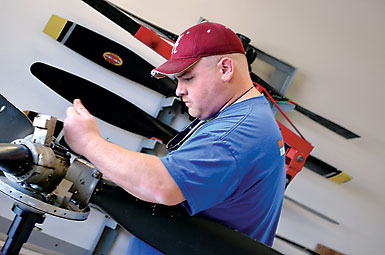A natural result of such industry growth is the need to extend and expand operations into new locations. In the United States today, there are three significant trends influencing the decisions made by aerospace manufacturers when they are evaluating potential locations for a new facility. The trends include a continued geographical shift, new ideas with regard to the supply chain approach, and changes in the types of incentives manufacturers are offered to locate their new facilities in certain areas.
Maximizing Geographical Shift
For two significant reasons, it makes sense for aerospace manufacturers to locate their operations within U.S. borders. First, most believe their need for workers with the specific technical skills they require cannot be fulfilled offshore. In addition, aerospace manufacturers cannot assure the safety of operations conducted in many other countries around the world, given the escalation of security risks and violent activity in today’s geopolitical climate.
Consequently, the U.S. aerospace industry will remain healthy for the time being. The recent establishment of the Southeast region of the country as a powerhouse of aerospace manufacturing growth is a testament to that fact. Appealing to manufacturers and their suppliers for its proximity to ports and highways and less expensive available labor with relatable automotive industry experience, the Southeast (comprising the states of Alabama, Florida, Georgia, and South Carolina) has been showing increased value of shipments and capital expenditures with three significant aerospace projects that have landed there: the $600 million Airbus A320 final assembly line at Alabama’s Brookley Aeroplex, Mobile; the state-of-the-art, $750 million Boeing 787 Dreamliner final assembly and delivery facility in Charleston, South Carolina; and the $500 million Center of Excellence projects for Northrop Grumman, located in St. Augustine and at Melbourne International Airport in Brevard County, Florida.
While the Southeast region exhibits significant aerospace growth, the northern states (represented by Illinois, Indiana, New York, Ohio, and Pennsylvania) are holding steady. In this region, employment remained relatively stable from 2007 through 2012, while both the total value of shipments and total capital expenditures have steadily increased since 2010.
In “traditional” aerospace manufacturing states such as California, Arizona, Kansas, Texas, and Washington, there is a trend toward declining aerospace manufacturing employment; however, it is important to recognize that California alone still has higher aerospace employment numbers than all of the Southeast states combined.
What does this shift in geography signify for aerospace manufacturing location decision-makers? There may be a strategic shift in resources under way — one that forecasts a further diversification of industry leaders and their suppliers, creating efficiencies, strengthening supply chains, maximizing resources, and enhancing productivity for all participants in the coming years.
The Southeast: A Powerhouse of Aerospace Manufacturing
Appealing to manufacturers and their suppliers for its proximity to ports and highways and less expensive available labor with relatable automotive industry experience, the Southeast has been showing increased value of shipments and capital expenditures with three significant aerospace projects that have landed there.
-
Airbus A320
Mobile, Alabama$600 million Airbus A320 final assembly line at Brookley Aeroplex
-
Boeing 787 Dreamliner
Charleston, South Carolina$750 million Boeing 787 Dreamliner final assembly and delivery facility
-
Northrop Grumman
Brevard County, Florida$500 million Center of Excellence projects for Northrop Grumman, located in St. Augustine and at Melbourne International Airport
Considering the millions of component parts required in the building of just one aircraft, it is no surprise that assessment of the available or developing supply chain is a key factor for aerospace manufacturers seeking a prime location. Efficient management of what is inevitably a large and diverse supply chain — from the base of that new location — is critical to continued success.
Adept management of the risk inherent in a large supply chain, as well as a move toward a higher level of performance predictability, is key. For this reason, a move toward the “lean” supply chain concept — one borrowed from the automotive industry — is taking hold in aerospace. Lean supply chain management, in which the supplier network is streamlined, integrates procurement and logistics to foster a true partner relationship with key suppliers — one based on enhanced predictability.
The concept (using principles like just-in-time deliveries to the assembly line and the Kanban system for inventory management) can transition a facility from typically having a reactive response to inventory shortfalls and equipment failure, into a proactive protocol that ensures that the right part is available at the right time, and machine maintenance is highly preventive and predictive in nature. Recent innovations in technology have driven the move toward these new ways of working.
As an aerospace manufacturer’s supply chain becomes leaner and more closely integrated through advanced technology, these ideas influence location decisions for new operations. Ideally, new facilities will be located to serve as a focal point of concentration for key supplier partnerships — ones that fuel — and profit from — newfound efficiencies in aerospace manufacturing performance.
Trends in Incentives
The final factor influencing location decision-making for aerospace manufacturers involves the incentives offered to locate in a specific area. It is nothing new for economic development organizations (EDOs) to be enthusiastic in offering incentives for large aerospace operations to locate in their areas. What is new are the types of incentives offered, and how quickly assistance programs at the state and local level are changing from the traditional into a creative mix of motivating factors.
A move toward the lean supply chain concept is taking hold in the aerospace industry. Up until now, location incentives have been centered around taxes: offers have included abatements, exemptions, and rebates for property, utility, sales, and usage taxes, as well as a general business privilege status that eases taxes in one way or another. Performance-based cash grants have also been popular. But, with many EDOs, especially the more progressive ones going after the highly valuable aerospace manufacturing sector, the offer of a simple tax incentive is quickly becoming old school.
Today, it is not uncommon for a community to be highly collaborative with the potential manufacturer in its approach to an incentive package. EDOs are increasingly willing to develop a comprehensive ecosystem of customized incentives that are specifically based on the particular needs of the aerospace company and the community it may call “home.”
For example, since aerospace companies have unique site needs for their operations, today’s EDOs are now offering help with site development and costs if the potential site has challenges with utilities, access roads, or the surrounding road network. When Boeing sought to locate in North Charleston, the incentive package included assistance with improving roads around the Boeing campus and building an additional interchange for the nearby interstate.
Another example of a highly collaborative incentive involved Airbus’ location in Mobile, Alabama. Key to an aerospace company’s success is the availability of an appropriately skilled workforce. Mobile recognized this when trying to attract Airbus, and through the Alabama Industrial Development and Training organization developed the Alabama Aviation Training Center, consisting of a highly tailored curriculum and state-of-the-art, hands-on facility to prepare workers for future employment on the Airbus assembly line.
Some EDOs may even go as far as influencing local government policies in order to entice a large manufacturer. These creative incentives include basic assistance with local permitting through the appointment of a liaison to help the company cut through red tape. They can also include more dramatic moves like those made in Virginia in 2006, which involved the development of regulatory incentives that, in essence, made tort law friendlier toward aerospace firms.
In Sum
From a natural geographical shift, to Internet-based innovations in supply chain management, to creative new collaborations that incentivize moves for aerospace manufacturers, there are notable trends affecting the decisions about where these companies locate today. Wise assessment of these trends — and the opportunities they represent — can help location decision-makers not only find the right site, but also take their companies to the leading edge of a new wave of aerospace manufacturing excellence.

